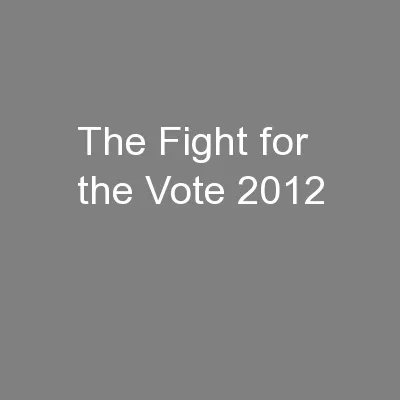

January 2012 2 Registering poor people to vote is like handing out burglary tools to criminals It is profoundly antisocial and unAmerican to empower the nonproductive segments of the population to destroy the country which is precisely why Barack Obama zealously supports registeri ID: 410946
Download Presentation The PPT/PDF document "The Fight for the Vote 2012" is the property of its rightful owner. Permission is granted to download and print the materials on this web site for personal, non-commercial use only, and to display it on your personal computer provided you do not modify the materials and that you retain all copyright notices contained in the materials. By downloading content from our website, you accept the terms of this agreement.
Slide1
The Fight for the Vote 2012
January 2012Slide2
2
Registering [poor people] to vote is like handing out burglary tools to criminals. It is profoundly antisocial and un-American to empower the nonproductive segments of the population to destroy the country — which is precisely why Barack Obama zealously supports registering welfare recipients to vote.
Columnist
Matthew
Vadum Slide3
3
“
Voting as a liberal. You know, that’s what kids do.
They don’t
have experience and just vote their feelings...”
New Hampshire House Speaker William O’Brien
Slide4
4
“[T]his
endless cheerleading — let’s go to the rock concerts and register the kids.
. . I’m just
saying we shouldn’t have these “Get Out The Vote” campaigns and make these statements: “Everyone has to vote. It’s your patriotic duty!” Well if you’re not paying attention, I think it’s your patriotic duty not to vote.
John
Stossel
, Fox NewsSlide5
Demographic Shifts5
From 2011 – 2031, 10,000 people per day will reach 65 years of age. For persons 80
and
over, the population growth
rate is twice that of those 65 and over and almost
4x that for the total population.
Growth rate for populations by ethnicity/race:
Hispanic/Latino 43%
Black 12%
Asian 43%
Non-Hispanic White 1.2% Slide6
Nature and Impact of Voting Restrictions6Slide7
New Voting Restrictions7
Restrictive photo ID:
7
passed,
37
introduced
Documentary proof of citizenship:
3 passed,
13
introduced
Making voter registration harder:
5
passed, 13 introduced
Reducing absentee and early voting:
5 passed, 9 introduced
Harder to restore voting rights:
2
executive actionsSlide8
No-Photo, No-Vote Voter ID Requirements8
34 states introduced laws to require some form of government-issued photo ID in order to vote.
Laws have passed in:
AL, KS, MS, RI, SC, TN, TX, WI
(Vetoed:
MN, MO, MT, NH & NC
)
Photo ID laws are pending:
MN, NH, PA, TN & VA
Constitutional Amendment Ballot Measure:
MOSlide9
Proof of Citizenship for Registration9
13 states introduced laws to require proof of citizenship for purposes of voter registration.
Laws have passed in:
KS, TN & AL
Proof of citizenship laws are pending:
SCSlide10
Rates of Proof of Identity & Citizenship10
11
%
of Americans lack photo ID
18
%
of Americans over 65 lack photo ID
25
%
of African Americans lack photo
ID
18%
of young people aged 18 – 24 lack photo ID
At
least 7%
of Americans lack proof of
citizenship
34
%
of women lack proof of
citizenship with
current legal nameSlide11
Restrictions on Voter Registration11
Texas and Florida passed legislation starkly restricting third-party voter registration drives with pending laws in South Carolina and Michigan.
Additional laws in Wisconsin and Ohio reducing ability of voters to move within counties and remain registeredSlide12
Restrictions on Voter Registration12
Hundreds of thousands
registered through drives in Florida in both 2004 and 2008
African-American and Hispanic voters are
twice
as likely to register through drives as white votersSlide13
Restrictions on Access to the Ballot13
Laws reducing early voting signed into law in five states:
FL, GA, OH, TN & WV
Elimination of “Golden Week” in Ohio
– overlap that allowed same-day registration during the first week of early voting. In-person voting period from 35 days to 11 with Sat afternoon and Sunday eliminated entirely.
Elimination of “Souls to the Polls Sunday”
in Florida – Sunday before Election Day and reduced early voting period from two weeks to one week. Slide14
Eliminating Sunday voting: Florida 2008
Hispanic voters
35%
25%
15%
5%
African-American voters
% of
CVAP
25%
15%
5%
%
of
CVAP
% voted Sunday
before
Election
Day
% voted Sunday before Election Day Slide15
Making it Harder to Restore Voting Rights15
Up
to
1 million
disenfranchised in Florida
*
1 in 4
is African American
*
150,000
had voting rights restored under Governor
Crist’s
process
Reversal of executive orders automatically restoring voting rights to persons with felony convictions
80,000
had voting
rights restored
in
Iowa under
Governor
Vilsack’s
orderSlide16
Assault on Student Rights16
Texas and Tennessee:
C
onceal-carry gun licenses
are
accepted; student
IDs
are
not
accepted
New Hampshire:
“
Voting as a liberal. You know, that’s what kids do.
They
don’t have experience and just vote their feelings...”
Maine:
targeting
students paying out-of-state tuition or
displaced
by natural disasterSlide17
17
79%
Source: Voting Law Changes in 2012, Brennan Center for JusticeSlide18
Demographics and Democratic Power18
Demographic population growth direct proportion to the populations most severely affected by restrictive voting laws
With respect to race, redistricting patterns may ultimately demonstrate a reinforcement of these patterns resulting in serious impact on the ability of populations to create and develop effective infrastructure for political engagement. Slide19
Brennan Center for JusticeVoting Rights and Elections Teamlawrence.norden@nyu.edu – Deputy Directormyrna.perez@nyu.edu – Senior Counsel
keesha.gaskins@nyu.edu – Senior Counsel
lee.rowland@nyu.edu - Counsel
diana.kasdan@nyu.edu - Counsel
19